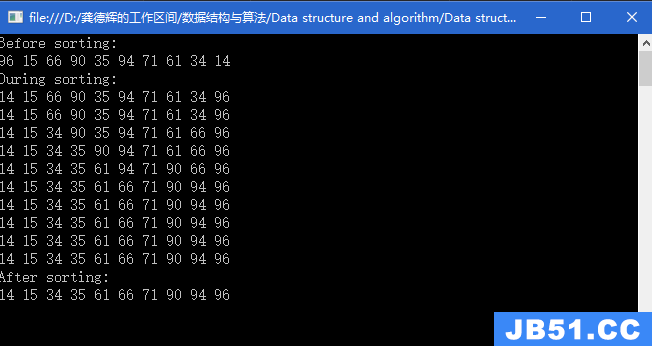一..实验目的
巩固栈和队列数据结构,学会运用栈和队列。
1.回顾栈和队列的逻辑结构和受限操作特点,栈和队列的物理存储结构和常见操作。
2.学习运用栈和队列的知识来解决实际问题。
3.进一步巩固程序调试方法。
4.进一步巩固模板程序设计。
二.实验时间
准备时间为第5周到第6周,具体集中实验时间为6周第2次课。2个学时。
三..实验内容
1.自己选择顺序或链式存储结构,定义一个空栈类,并定义入栈、出栈、取栈元素基本操作。然后在主程序中对给定的N个数据进行验证,输出各个操作结果。
2.自己选择顺序或链式存储结构,定义一个空栈队列,并定义入栈、出栈、取栈元素基本操作。然后在主程序中对给定的N个数据进行验证,输出各个操作结果。
3.编程实现一个十进制数转换成二进制数。要求,要主程序中输出一个10进度数,输出其对应的2进制数序列。
前两题是必做题,第3题是选做题。
四.实验总结
栈和队列是两种常用的数据结构,栈和队列是操作受限的线性表,栈和队列的数据元素具有单一的前驱和后继的线性关系;栈和队列又是两种重要的抽象数据类型。
栈是限定在表尾进行插入和删除操作的线性表允许插入和删除的一端为栈顶,另一端为栈底,出栈元素只能是栈顶元素,后进先出,相邻元素具有前驱与后继关系。
队列是只允许在一端进行插入操作,在另一端进行删除操作的线性表。允许插入的一端为队尾,允许删除的一端为队头,先进先出,相邻元素具有前驱与后继关系。
1.
#ifndef seqstack_h
#define seqstack_h
const int stacksize=10;
template<class datatype>
class seqstack
{
public:
seqstack();
~seqstack(){}
void push(datatype x);
datatype pop();
datatype gettop();
int empty();
private:
datatype data[stacksize];
int top;
};
#endif
#include"seqstack.h"
template<class datatype>
seqstack<datatype>::seqstack()
{
top=-1;
}
template<class datatype>
void seqstack<datatype>::push(datatype x)
{
if(top==stacksize-1)throw"上溢";
top++;
data[top]=x;
}
template<class datatype>
datatype seqstack<datatype>::pop()
{
datatype x;
if(top==-1)throw"下溢";
x=data[top--];
return x;
}
template<class datatype>
datatype seqstack<datatype>::gettop()
{
if(top!=-1);
return data[top];
}
template<class datatype>
int seqstack<datatype>::empty()
{
if(top==-1) return 1;
else return 0;
}
#include<iostream>
using namespace std;
#include"seqstack.cpp"
void main()
{
seqstack<int> s;
if(s.empty())
cout<<"栈为空"<<endl;
else
cout<<"栈非空"<<endl;
cout<<"对1和5执行入栈操作"<<endl;
s.push(1);
s.push(5);
cout<<"栈顶元素为"<<endl;
cout<<s.gettop<<endl;
cout<<"执行一次出栈操作"<<endl;
s.pop();
cout<<"栈顶元素为"<<endl;
cout<<s.gettop<<endl;
}
2.
#ifndef linkqueue_h
#define linkqueue_h
template<class datatype>
struct node
{
datatype data;
node<datatype> *next;
};
template<class datatype>
class linkqueue
{
public:
linkqueue();
~linkqueue();
void enqueue(datatype x);
datatype dequeue();
datatype getqueue();
int empty();
private:
node<datatype> *front,*rear;
};
#endif
#include"linkqueue.h"
template<class datatype>
linkqueue<datatype>::linkqueue()
{
node<datatype> *s=NULL;
s=new node<datatype>;
s->next=NULL;
front=rear=s;
}
template<class datatype>
linkqueue<datatype>::~linkqueue()
{
node<datatype> *p=NULL;
while(front!=NULL)
{
p=front->next;
delete front;
front=p;
}
}
template<class datatype>
void linkqueue<datatype>::enqueue(datatype x)
{
node<datatype> *s=NULL;
s=new node<datatype>;
s->data=x;
s->next=NULL;
rear->next=s;
rear=s;
}
template<class datatype>
datatype linkqueue<datatype>::dequeue()
{
node<datatype> *p=NULL;
int x;
if(rear==front)throw"下溢";
p=front->next;
x=p->data;
front->next=p->next;
if(p->next==NULL)rear=front;
delete p;
return x;
}
template<class datatype>
datatype linkqueue<datatype>::getqueue()
{
if(front!=rear)
return front->next->data;
}
template<class datatype>
int linkqueue<datatype>::empty()
{
if(front==rear) return 1;
else return 0;
}
#include<iostream>
using namespace std;
#include"linkqueue.cpp"
void main()
{
linkqueue<int> q;
if(q.empty())
cout<<"队列为空"<<endl;
else
cout<<"队列非空"<<endl;
cout<<"对元素1和5执行入队操作"<<endl;
try
{
q.enqueue(1);
q.enqueue(5);
}
catch(char *wrong)
{
cout<<wrong<<endl;
}
cout<<"查看队头元素:"<<endl;
cout<<q.getqueue<<endl;
cout<<"执行出队操作:"<<endl;
try
{
q.dequeue();
}
catch(char *wrong)
{
cout<<wrong<<endl;
}
cout<<"查看队头元素:"<<endl;
cout<<q.getqueue<<endl;
}


